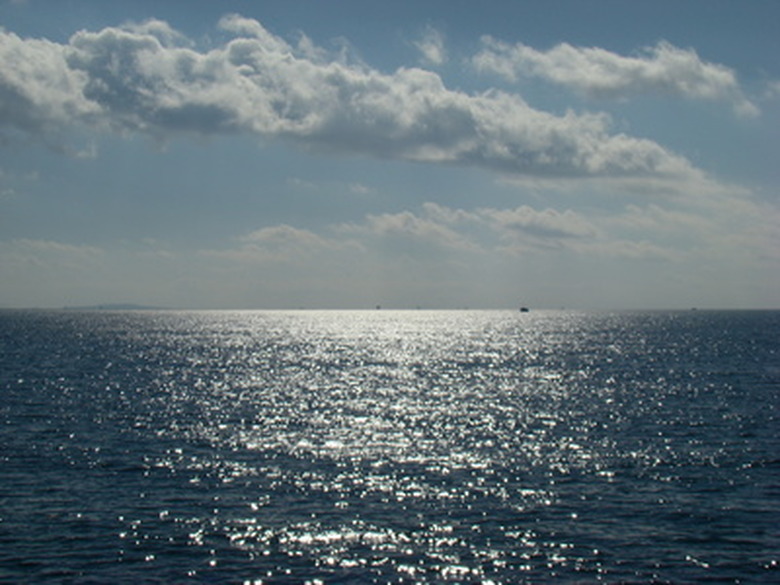How Do Ocean Currents Move?
Many forces combine to move ocean water. Tides ebb and flow because of the gravity between the Earth and the moon.
Wind can also move water, and the Earth's rotation adds a direction, but the main factors in the ocean's strongest and most stable currents are temperature, salinity and density.
TL;DR (Too Long; Didn't Read)
The intensity of the sun controls the ocean's temperature at the surface. Warm water is less dense than cold water. Cold water, dense with nutrients, is formed at the poles. When ocean water freezes, it leaves behind dense, salty water that sinks rapidly. Creation of this cold, dense water pushes deep water all around the world, forming ocean currents.
Surface Ocean Currents
Surface Ocean Currents
The wind plays a major role in how surface ocean currents are created. Like regular currents in the water, there are winds that blow consistently on certain parts of the Earth.
Let's say that every day, during a certain season, a strong wind started to blow from the north to the south along the shores of a continent. Think of the force of this wind like a hand gently pushing water. The displaced water is turned oceanward by the Earth's rotation.
Why doesn't this phenomenon, also known as the Coriolis Effect, cause the ocean to recede like it does at low tide? Is it because the wind only moves the top layer of water? No – underneath that surface current, cold, nutrient-rich water rushes in to take the place of the surface water.
Though the wind moves surface water first, eventually, deep ocean water is affected by surface weather as well.
Deep Ocean Currents
Deep Ocean Currents
Currents in the deep ocean are caused mostly by a phenomenon called thermohaline circulation. "Thermohaline" is a fancy combination of the Greek roots for salt (-haline) and temperature (thermo-).
Thermohaline circulation starts in the North Atlantic Ocean where the water is really cold (much colder than the ocean off the coast of Cape Cod or Maine, where brutal winters freeze freshwater lakes, ponds and even rivers, but not the oceans). In the North Atlantic, however, it can get so cold that even the ocean water will freeze. When salt water freezes, it leaves behind a lot of extra salt, making for really dense water.
Think of that dense water as heavy. That heavy water sinks rapidly in areas where polar ice has formed.
This cold, dense, sinking water is the foundation for a system of currents that covers the whole globe. As this cold water travels away from the ice to sunnier latitudes, it starts to warm. Living creatures like microscopic algae use the nutrients for food and stabilize the entire food chain. As the water becomes warmer and less dense, it begins to rise. Cold countries depend on warm-water currents to make life tolerable where cold air dominates the climate.
Deep water currents move slowly and predictably across the globe in a cyclical system often called the "Global Conveyor Belt."
The water takes some detours, but in general, the currents follow a consistent pattern. Cold, dense water at the poles becomes warm and less dense at the equator, and then it becomes cold and dense again as it reaches the opposite pole.
Currents and Climate
Currents and Climate
Though it may not seem like it some days, the planet's overall temperature is warming. Higher temperatures are preventing ice from forming in the polar regions.
In fact, Arctic ice is at an all-time low and is still melting. Less ice forming means that less cold, dense water is sinking. Without cold, salty water rushing to the depths, ocean currents are moving more slowly. Some experts say that the increase in freshwater input could eventually cause the currents to stop moving altogether.
Without currents to help regulate the temperature of both the air and the water, climates all over the world are at risk of changing drastically.
Cite This Article
MLA
Bornhop, Emily. "How Do Ocean Currents Move?" sciencing.com, https://www.sciencing.com/do-ocean-currents-move-6383087/. 22 November 2019.
APA
Bornhop, Emily. (2019, November 22). How Do Ocean Currents Move?. sciencing.com. Retrieved from https://www.sciencing.com/do-ocean-currents-move-6383087/
Chicago
Bornhop, Emily. How Do Ocean Currents Move? last modified March 24, 2022. https://www.sciencing.com/do-ocean-currents-move-6383087/
